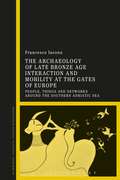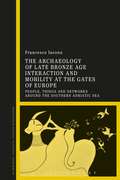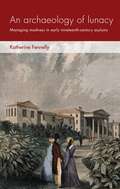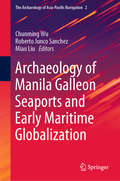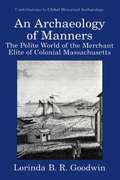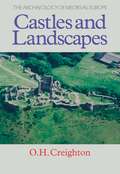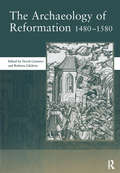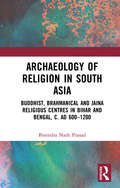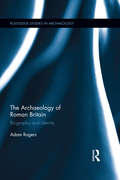- Table View
- List View
The Archaeology of Knowledge Traditions of the Indian Ocean World
by Himanshu Prabha RayThis book examines knowledge traditions that held together the fluid and overlapping maritime worlds of the Indian Ocean in the premodern period, as evident in the material and archaeological record. It breaks new ground by shifting the focus from studying cross-pollination of ideas from textual sources to identifying this exchange of ideas in archaeological and historical documentation. The themes covered in the book include conceptualization of the seas and maritime landscapes in Sanskrit, Arabic and Chinese narratives; materiality of knowledge production as indicated in the archaeological record of communities where writing on stone first appears; and anchoring the coasts, not only through an understanding of littoral shrines and ritual landscapes, but also by an analysis of religious imagery on coins, more so at the time of the introduction of new religions such as Islam in the Indian Ocean around the eighth century. This volume will be of great interest to researchers and scholars of archaeology, anthropology, museum and heritage studies, Indian Ocean studies, maritime studies, South and Southeast Asian studies, religious studies and cultural studies.
The Archaeology of Knowledge Traditions of the Indian Ocean World
by Himanshu Prabha RayThis book examines knowledge traditions that held together the fluid and overlapping maritime worlds of the Indian Ocean in the premodern period, as evident in the material and archaeological record. It breaks new ground by shifting the focus from studying cross-pollination of ideas from textual sources to identifying this exchange of ideas in archaeological and historical documentation. The themes covered in the book include conceptualization of the seas and maritime landscapes in Sanskrit, Arabic and Chinese narratives; materiality of knowledge production as indicated in the archaeological record of communities where writing on stone first appears; and anchoring the coasts, not only through an understanding of littoral shrines and ritual landscapes, but also by an analysis of religious imagery on coins, more so at the time of the introduction of new religions such as Islam in the Indian Ocean around the eighth century. This volume will be of great interest to researchers and scholars of archaeology, anthropology, museum and heritage studies, Indian Ocean studies, maritime studies, South and Southeast Asian studies, religious studies and cultural studies.
The Archaeology of Late Bronze Age Interaction and Mobility at the Gates of Europe: People, Things and Networks around the Southern Adriatic Sea
by Dr Francesco IaconoInteraction and mobility have attracted much interest in research within scholarly fields as different as archaeology, history, and more broadly the humanities. Critically assessing some of the most widespread views on interaction and its social impact, this book proposes an innovative perspective which combines radical social theory and currently burgeoning network methodologies.Through an in-depth analysis of a wealth of data often difficult to access, and illustrated by many diagrams and maps, the book highlights connections and their social implications at different scales ranging from the individual settlement to the Mediterranean. The resulting diachronic narrative explores social and economic trajectories over some seven centuries and sheds new light on the broad historical trends affecting the life of people living around the Middle Sea. The Bronze Age is the first period of intense interaction between early state societies of the Eastern Mediterranean and the small-scale communities to the west of Greece, with people and goods moving at a scale previously unprecedented. This encounter is explored from the vantage point of one of its main foci: Apulia, located in the southern Adriatic, at the junction between East and West and the entryway of one of the major routes for the resource-rich European continent.
The Archaeology of Late Bronze Age Interaction and Mobility at the Gates of Europe: People, Things and Networks around the Southern Adriatic Sea
by Dr Francesco IaconoInteraction and mobility have attracted much interest in research within scholarly fields as different as archaeology, history, and more broadly the humanities. Critically assessing some of the most widespread views on interaction and its social impact, this book proposes an innovative perspective which combines radical social theory and currently burgeoning network methodologies.Through an in-depth analysis of a wealth of data often difficult to access, and illustrated by many diagrams and maps, the book highlights connections and their social implications at different scales ranging from the individual settlement to the Mediterranean. The resulting diachronic narrative explores social and economic trajectories over some seven centuries and sheds new light on the broad historical trends affecting the life of people living around the Middle Sea. The Bronze Age is the first period of intense interaction between early state societies of the Eastern Mediterranean and the small-scale communities to the west of Greece, with people and goods moving at a scale previously unprecedented. This encounter is explored from the vantage point of one of its main foci: Apulia, located in the southern Adriatic, at the junction between East and West and the entryway of one of the major routes for the resource-rich European continent.
The Archaeology of Lucanian Cult Places: Fourth Century BC to the Early Imperial Age
by Ilaria BattiloroWith the emergence and structuring of the Lucanian ethnos during the fourth century BC, a network of cult places, set apart from habitation spaces, was created at the crossroads of the most important communication routes of ancient Lucania. These sanctuaries became centers of social and political aggregation of the local communities: a space in which the community united for all the social manifestations that, in urban societies, were usually performed within the city space. With a detailed analysis of the archaeological record, this study traces the historical and archaeological narrative of Lucanian cult places from their creation to the Late Republican Age, which saw the incorporation of southern Italy into the Roman state. By placing the sanctuaries within their territorial, political, social, and cultural context, Battiloro offers insight into the diachronic development of sacred architecture and ritual customs in ancient Lucania. The author highlights the role of material evidence in constructing the significance of sanctuaries in the historical context in which they were used, and crucial new evidence from the most recent archaeological investigations is explored in order to define dynamics of contact and interaction between Lucanians and Romans on the eve of the Roman conquest.
The Archaeology of Lucanian Cult Places: Fourth Century BC to the Early Imperial Age
by Ilaria BattiloroWith the emergence and structuring of the Lucanian ethnos during the fourth century BC, a network of cult places, set apart from habitation spaces, was created at the crossroads of the most important communication routes of ancient Lucania. These sanctuaries became centers of social and political aggregation of the local communities: a space in which the community united for all the social manifestations that, in urban societies, were usually performed within the city space. With a detailed analysis of the archaeological record, this study traces the historical and archaeological narrative of Lucanian cult places from their creation to the Late Republican Age, which saw the incorporation of southern Italy into the Roman state. By placing the sanctuaries within their territorial, political, social, and cultural context, Battiloro offers insight into the diachronic development of sacred architecture and ritual customs in ancient Lucania. The author highlights the role of material evidence in constructing the significance of sanctuaries in the historical context in which they were used, and crucial new evidence from the most recent archaeological investigations is explored in order to define dynamics of contact and interaction between Lucanians and Romans on the eve of the Roman conquest.
An archaeology of lunacy: Managing madness in early nineteenth-century asylums (Social Archaeology and Material Worlds)
by Katherine FennellyAn archaeology of lunacy is a materially focused exploration of the first wave of public asylum building in Britain and Ireland, which took place during the late-Georgian and early Victorian period. Examining architecture and material culture, the book proposes that the familiar asylum archetype, usually attributed to the Victorians, was in fact developed much earlier. It looks at the planning and construction of the first public asylums and assesses the extent to which popular ideas about reformed management practices for the insane were applied at ground level. Crucially, it moves beyond doctors and reformers, repopulating the asylum with the myriad characters that made up its everyday existence: keepers, clerks and patients. Contributing to archaeological scholarship on institutions of confinement, the book is aimed at academics, students and general readers interested in the material environment of the historic lunatic asylum.
An archaeology of lunacy: Managing madness in early nineteenth-century asylums (Social Archaeology and Material Worlds)
by Katherine FennellyAn archaeology of lunacy is a materially focused exploration of the first wave of public asylum building in Britain and Ireland, which took place during the late-Georgian and early Victorian period. Examining architecture and material culture, the book proposes that the familiar asylum archetype, usually attributed to the Victorians, was in fact developed much earlier. It looks at the planning and construction of the first public asylums and assesses the extent to which popular ideas about reformed management practices for the insane were applied at ground level. Crucially, it moves beyond doctors and reformers, repopulating the asylum with the myriad characters that made up its everyday existence: keepers, clerks and patients. Contributing to archaeological scholarship on institutions of confinement, the book is aimed at academics, students and general readers interested in the material environment of the historic lunatic asylum.
Archaeology of Manila Galleon Seaports and Early Maritime Globalization (The Archaeology of Asia-Pacific Navigation #2)
by Chunming Wu Roberto Junco Sanchez Miao LiuThis book focuses on the archaeological and historical research on the seaport heritage of galleon navigation in Asia-Pacific region. It reconstructs the Manila Galleons’ era of early maritime globalization, established and operated by Spanish navigators from the 16th to 19th centuries. The galleons sailed across the Pacific via the hub seaports and trade centers of Manila in the Philippines and Acapulco in Mexico, forming a prosperous sea route connecting eastern Asia and New Spain on the American continent for more than 250 years. This pioneering navigation of the pan-Pacific regions promoted early global maritime trade along the new Maritime Silk Road between the East and the West.Written by archaeologists and cultural historians from America, Mexico, Japan, the Philippines, Mainland China, Hong Kong and Taiwan, it presents the latest investigations and research on the galleon-affiliated seaports, including Acapulco and San Blas in Mexico, Guam, Manila in Philippines, Yuegang (Crescent Harbor), Xiamen (Amoy), Keelung and Macao in China, Nagasaki in Japan. This joint research sheds new light on the history of navigation and maritime trade between galleon-affiliated harbors; the origin, production, transport and trade of the galleon cargo; social cultural exchange along the new Maritime Silk Road in the pan-Pacific region; and the history of maritime globalization in last 500 years. It offers a new perspective on maritime archaeology and traces the different stages of the galleon trade and affiliated maritime history, including "Yuegang Outbound", "Manila Entrepotting" and "Bound for Acapulco", presenting a panoramagram of Spanish pan-Pacific trade and early maritime globalization.
An Archaeology of Manners: The Polite World of the Merchant Elite of Colonial Massachusetts (Contributions To Global Historical Archaeology)
by Lorinda B.R. GoodwinA glance at the title of this book might well beg the question “What in heaven’s name does archaeology have to do with manners? We cannot dig up manners or mannerly behavior—or can we?” One might also ask “Why is mannerly behavior important?” and “What can archaeology contribute to our understanding of the role of manners in the devel- ment of social relations and cultural identity in early America?” English colonists in America and elsewhere sought to replicate English notions of gentility and social structure, but of necessity div- ged from the English model. The first generation of elites in colonial America did not spring from the landed gentry of old England. Rather, they were self-made, newly rich, and newly possessed of land and other trappings of England’s genteel classes. The result was a new model of gentry culture that overcame the contradiction between a value system in which gentility was conferred by birth, and the new values of bo- geois materialism and commercialism among the emerging colonial elites. Manners played a critical role in the struggle for the cultural legitimacy of gentility; mannerly behavior—along with exhibition of refined taste in architecture, fashionable clothing, elegant furnishings, and literature—provided the means through which the new-sprung colonial elites defined themselves and validated their claims on power and prestige to accompany their newfound wealth.
The Archaeology of Market Capitalism: A Western Australian Perspective (Contributions To Global Historical Archaeology)
by Gaye NaytonThe area claimed by the British Empire as Western Australia was primarily colonized through two major thrusts: the development of the Swan River Colony to the southwest in 1829, and the 1863 movement of Australian born settlers to colonize the northwest region. The Western Australian story is overwhelmingly the story of the spread of market capitalism, a narrative which is at the foundation of modern western world economy and culture. Due to the timing of settlement in Western Australia there was a lack of older infrastructure patterns based on industrial capitalism to evoke geographical inertia to modify and deform the newer system in many ways making the systemic patterns which grew out of market capitalist forces clearer and easier to delineate than in older settlement areas. However, the struggle between the forces of market capitalism, settlers and indigenous Australians over space, labor, physical and economic resources and power relationships are both unique to place and time and universal in allowing an understanding of how such complicated regional, interregional and global forces shape a settler society.Through an examination of historical records, town layout and architecture, landscape analysis, excavation data, and material culture analysis, the author created a nuanced understanding of the social, economic, and cultural developments that took place during this dynamic period in Australian history. In examining this complex settlement history, the author employed several different research methodologies in parallel, to create a comprehensive understanding of the area. Her research techniques will be invaluable to researchers struggling to understand similarly complex sociocultural evolutions throughout the globe.
The Archaeology of Medieval Europe: Castles and Landscapes
by O. H. CreightonCastles were among the most dominant features of the medieval landscape, and many remain impressive structures to the present day. This work looks at castles in a new light, using the theories and methods of landscape studies. Castles are examined not as an isolated phenomenon, but in relation to their surrounding human as well as physical areas. Taking a thematic approach, the study examines a broad range of evidence, archaeological, documentary and topographical, to assess the contribution of these structures on the evolution of the medieval landscape. The imprint of castles on the human landscape was powerful and often long-lived. As imposing icons of status and lordship, castles re-shaped the landscape in the minds of contemporaries, while as estate centres and manors they were closely connected with their surrounding hinterlands. The settlement landscape was also deeply affected by castle building as their powerful aristocratic owners fostered new towns and villages, while other communities were disrupted by their construction. The types of sites chosen for castles are also examined, as are the features that often accompanied them, including churches, mills, monasteries, deer parks, fishponds and gardens. Throughout, this book challenges many of our perceptions about medieval castles and presents some new avenues for future research. Alternative ISBNs 9781904768678
The Archaeology of Medieval Europe: Castles and Landscapes (PDF)
by O. H. CreightonCastles were among the most dominant features of the medieval landscape, and many remain impressive structures to the present day. This work looks at castles in a new light, using the theories and methods of landscape studies. Castles are examined not as an isolated phenomenon, but in relation to their surrounding human as well as physical areas. Taking a thematic approach, the study examines a broad range of evidence, archaeological, documentary and topographical, to assess the contribution of these structures on the evolution of the medieval landscape. The imprint of castles on the human landscape was powerful and often long-lived. As imposing icons of status and lordship, castles re-shaped the landscape in the minds of contemporaries, while as estate centres and manors they were closely connected with their surrounding hinterlands. The settlement landscape was also deeply affected by castle building as their powerful aristocratic owners fostered new towns and villages, while other communities were disrupted by their construction. The types of sites chosen for castles are also examined, as are the features that often accompanied them, including churches, mills, monasteries, deer parks, fishponds and gardens. Throughout, this book challenges many of our perceptions about medieval castles and presents some new avenues for future research. Alternative ISBN 9781904768678
The Archaeology of Mediterranean Placemaking: Butrint and the Global Heritage Industry
by Richard HodgesButrint has been one of the largest archaeological projects in the Mediterranean over the last two decades. Major excavations and a multi-volume series of accompanying scientific publications have made this a key site for our developing understanding of the Roman and Medieval Mediterranean. Through this set of interwoven reflections about the archaeology and cultural heritage history of his twenty-year odyssey in south-west Albania, Richard Hodges considers how the Butrint Foundation protected and enhanced Butrint's spirit of place for future generations. Hodges reviews Virgil's long influence on Butrint and how its topographic archaeology has now helped to invent a new narrative and identity. He then describes the struggle of placemaking in Albania during the early post-communist era, and finally asks, in the light of the Butrint Foundation's experience, who matters in the shaping of a place – international regulations, the nation, the archaeologist, the visitor, the local community or some combination of all of these stakeholders? With appropriate maps and photographs, this book aims to offer an unusual but important new direction for archaeology in the Mediterranean. It should be essential reading for archaeologists, classical historians, medievalists, cultural heritage specialists, tourism specialists as well as those interested in the Mediterranean's past and future.
The Archaeology of Mediterranean Placemaking: Butrint and the Global Heritage Industry
by Richard HodgesButrint has been one of the largest archaeological projects in the Mediterranean over the last two decades. Major excavations and a multi-volume series of accompanying scientific publications have made this a key site for our developing understanding of the Roman and Medieval Mediterranean. Through this set of interwoven reflections about the archaeology and cultural heritage history of his twenty-year odyssey in south-west Albania, Richard Hodges considers how the Butrint Foundation protected and enhanced Butrint's spirit of place for future generations. Hodges reviews Virgil's long influence on Butrint and how its topographic archaeology has now helped to invent a new narrative and identity. He then describes the struggle of placemaking in Albania during the early post-communist era, and finally asks, in the light of the Butrint Foundation's experience, who matters in the shaping of a place – international regulations, the nation, the archaeologist, the visitor, the local community or some combination of all of these stakeholders? With appropriate maps and photographs, this book aims to offer an unusual but important new direction for archaeology in the Mediterranean. It should be essential reading for archaeologists, classical historians, medievalists, cultural heritage specialists, tourism specialists as well as those interested in the Mediterranean's past and future.
The Archaeology of Mesopotamia: Theories and Approaches (Approaching the Ancient World)
by Roger MatthewsThe only critical guide to the theory and method of Mesopotamian archaeology, this innovative volume evaluates the theories, methods, approaches and history of Mesopotamian archaeology from its origins in the nineteenth century up to the present day. Ancient Mesopotamia (modern Iraq), was the original site of many of the major developments in human history, such as farming, the rise of urban literate societies and the first great empires of Akkad, Babylonia and Assyria. Dr. Matthews places the discipline within its historical and social context, and explains how archaeologists conduct their research through excavation, survey and other methods. In four fundamental chapters, he uses illustrated case-studies to show how archaeologists have approached central themes such as: * the shift from hunting to farming* complex societies* empires and imperialism* everyday life. This will be both an ideal introductory work and useful as background reading on a wide range of courses.
The Archaeology of Mesopotamia: Theories and Approaches (Approaching the Ancient World)
by Roger MatthewsThe only critical guide to the theory and method of Mesopotamian archaeology, this innovative volume evaluates the theories, methods, approaches and history of Mesopotamian archaeology from its origins in the nineteenth century up to the present day. Ancient Mesopotamia (modern Iraq), was the original site of many of the major developments in human history, such as farming, the rise of urban literate societies and the first great empires of Akkad, Babylonia and Assyria. Dr. Matthews places the discipline within its historical and social context, and explains how archaeologists conduct their research through excavation, survey and other methods. In four fundamental chapters, he uses illustrated case-studies to show how archaeologists have approached central themes such as: * the shift from hunting to farming* complex societies* empires and imperialism* everyday life. This will be both an ideal introductory work and useful as background reading on a wide range of courses.
The Archaeology of Myth: Papers on Old Testament Tradition (Bibleworld Ser.)
by N. WyattMyth as a category is often explicitly denied as being present in the Bible. Studies of Israelite religion take a largely historical approach. 'The Archaeology of Myth' highlights the importance of mythological categories in discussing any religion, and especially Israelite religion. The essays explore key biblical narratives and themes - Jacob's dream, the story of Dinah and Shechem, the seventy sons of Athirat, the old men of Deuteronomy - tracing their development from primitive forms to biblical text. The book offers a theoretical analysis of the biblical treatment of myth and its role in the shaping of memories and values.
The Archaeology of Myth: Papers on Old Testament Tradition
by N. WyattMyth as a category is often explicitly denied as being present in the Bible. Studies of Israelite religion take a largely historical approach. 'The Archaeology of Myth' highlights the importance of mythological categories in discussing any religion, and especially Israelite religion. The essays explore key biblical narratives and themes - Jacob's dream, the story of Dinah and Shechem, the seventy sons of Athirat, the old men of Deuteronomy - tracing their development from primitive forms to biblical text. The book offers a theoretical analysis of the biblical treatment of myth and its role in the shaping of memories and values.
The Archaeology of Reformation,1480-1580
by David GaimsterTraditionally the Reformation has been viewed as responsible for the rupture of the medieval order and the foundation of modern society. Recently historians have challenged the stereotypical model of cataclysm, and demonstrated that the religion of Tudor England was full of both continuities and adaptations of traditional liturgy, ritual and devoti
The Archaeology of Reformation,1480-1580
by David GaimsterTraditionally the Reformation has been viewed as responsible for the rupture of the medieval order and the foundation of modern society. Recently historians have challenged the stereotypical model of cataclysm, and demonstrated that the religion of Tudor England was full of both continuities and adaptations of traditional liturgy, ritual and devoti
Archaeology of Religion in South Asia: Buddhist, Brahmanical and Jaina Religious Centres in Bihar and Bengal, c. AD 600–1200
by Birendra Nath PrasadIn the religious landscape of early medieval (c. AD 600-1200) Bihar and Bengal, poly-religiosity was generally the norm than an exception, which entailed the evolution of complex patterns of inter-religious equations. Buddhism, Brahmanism and Jainism not only coexisted but also competed for social patronage, forcing them to enter into complex interactions with social institutions and processes. Through an analysis of the published archaeological data, this work explores some aspects of the social history of Buddhist, Brahmanical and Jaina temples and shrines, and Buddhist stūpas and monasteries in early medieval Bihar and Bengal. This archaeological history of religions questions many ‘established’ textual reconstructions, and enriches our understanding of the complex issue of the decline of Buddhism in this area. Please note: Taylor & Francis does not sell or distribute the Hardback in India, Pakistan, Nepal, Bhutan, Bangladesh and Sri Lanka.
Archaeology of Religion in South Asia: Buddhist, Brahmanical and Jaina Religious Centres in Bihar and Bengal, c. AD 600–1200
by Birendra Nath PrasadIn the religious landscape of early medieval (c. AD 600-1200) Bihar and Bengal, poly-religiosity was generally the norm than an exception, which entailed the evolution of complex patterns of inter-religious equations. Buddhism, Brahmanism and Jainism not only coexisted but also competed for social patronage, forcing them to enter into complex interactions with social institutions and processes. Through an analysis of the published archaeological data, this work explores some aspects of the social history of Buddhist, Brahmanical and Jaina temples and shrines, and Buddhist stūpas and monasteries in early medieval Bihar and Bengal. This archaeological history of religions questions many ‘established’ textual reconstructions, and enriches our understanding of the complex issue of the decline of Buddhism in this area. Please note: Taylor & Francis does not sell or distribute the Hardback in India, Pakistan, Nepal, Bhutan, Bangladesh and Sri Lanka.
The Archaeology of Roman Britain: Biography and Identity (Routledge Studies in Archaeology)
by Adam RogersWithin the colonial history of the British Empire there are difficulties in reconstructing the lives of people that came from very different traditions of experience. The Archaeology of Roman Britain argues that a similar critical approach to the lives of people in Roman Britain needs to be developed, not only for the study of the local population but also those coming into Britain from elsewhere in the Empire who developed distinctive colonial lives. This critical, biographical approach can be extended and applied to places, structures, and things which developed in these provincial contexts as they were used and experienced over time. This book uniquely combines the study of all of these elements to access the character of Roman Britain and the lives, experiences, and identities of people living there through four centuries of occupation. Drawing on the concept of the biography and using it as an analytical tool, author Adam Rogers situates the archaeological material of Roman Britain within the within the political, geographical, and temporal context of the Roman Empire. This study will be of interest to scholars of Roman archaeology, as well as those working in biographical themes, issues of colonialism, identity, ancient history, and classics.
The Archaeology of Roman Britain: Biography and Identity (Routledge Studies in Archaeology)
by Adam RogersWithin the colonial history of the British Empire there are difficulties in reconstructing the lives of people that came from very different traditions of experience. The Archaeology of Roman Britain argues that a similar critical approach to the lives of people in Roman Britain needs to be developed, not only for the study of the local population but also those coming into Britain from elsewhere in the Empire who developed distinctive colonial lives. This critical, biographical approach can be extended and applied to places, structures, and things which developed in these provincial contexts as they were used and experienced over time. This book uniquely combines the study of all of these elements to access the character of Roman Britain and the lives, experiences, and identities of people living there through four centuries of occupation. Drawing on the concept of the biography and using it as an analytical tool, author Adam Rogers situates the archaeological material of Roman Britain within the within the political, geographical, and temporal context of the Roman Empire. This study will be of interest to scholars of Roman archaeology, as well as those working in biographical themes, issues of colonialism, identity, ancient history, and classics.

